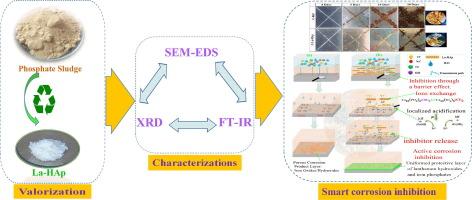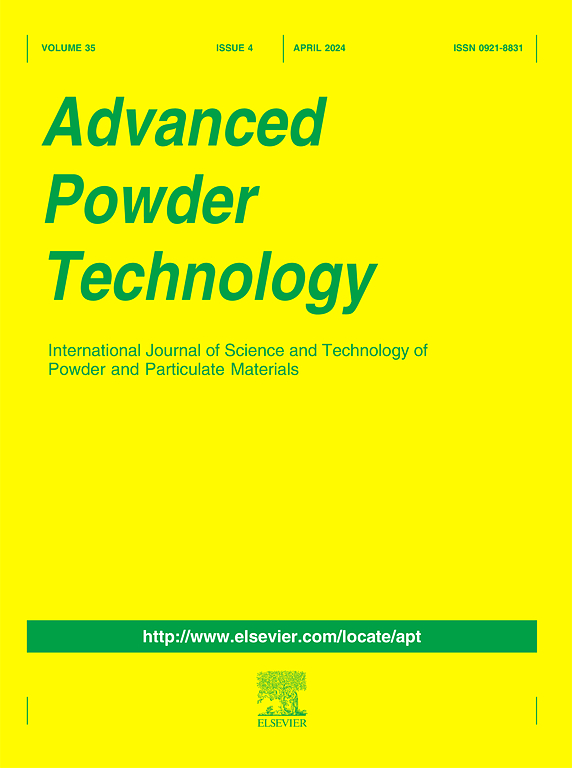用于智能绿色防护涂料的防腐颜料:掺入了从磷矿开采业副产品中提取的羟基磷灰石镧的醇酸树脂涂料
IF 4.2
2区 工程技术
Q2 ENGINEERING, CHEMICAL
引用次数: 0
摘要
智能防腐蚀涂层作为一种保护金属的方法,已经引起了人们的极大兴趣。这种方法通过提供对腐蚀过程的先进控制,为减轻腐蚀提供了一种有效的策略。在这项研究中,利用磷酸盐污泥(PS)废料成功合成了负载镧的羟基磷灰石颜料(La-HAp)。该颜料被加入醇酸树脂涂层中,为暴露在盐溶液中的低碳钢提供智能腐蚀保护。利用傅立叶变换红外光谱、XRD 和 SEM-EDS 等多种分析技术对合成的颜料进行了表征。使用线性极化和 EIS 技术评估了 La-HAp 对浸没在 3% NaCl 溶液中的低碳钢的抑制性能。研究结果表明,La-HAp 具有显著的抑制效果,抑制效率达到 82%。进一步的研究使用 EIS 比较了改性(C-La-HAp)和参考(C-Ref)醇酸树脂涂层对碳钢的保护能力。结果表明,5% La-HAp 的腐蚀保护能力明显增强,在侵蚀性溶液中浸泡四周后,极化电阻为 19.7 MΩ-cm2。这种耐腐蚀性主要归因于对腐蚀性环境形成的屏障和 HAp 对 Cl- 离子的捕获,以及 La、磷酸盐和钙离子的释放。La 离子与阴极区产生的 OH 离子反应,形成一层均匀的氢氧化铝保护层,而正磷酸盐铁则在阳极部位提供额外的保护。这种协同作用机制使醇酸树脂具有智能缓蚀特性,可有效抵御腐蚀介质的破坏作用。本文章由计算机程序翻译,如有差异,请以英文原文为准。

Anticorrosive pigment for smart and green protective coatings: An alkyd resin coating incorporating lanthanum-loaded hydroxyapatite, derived from a phosphate mining industry by-product
Intelligent anti-corrosive coatings have gained considerable interest as a method to protect metals. This approach offers an effective strategy for mitigating corrosion by providing advanced control over the process. In this research, lanthanum-loaded hydroxyapatite pigment (La-HAp) was successfully synthesized using phosphate sludge (PS) waste. The pigment was incorporated into an alkyd resin coating to provide smart corrosion protection for mild steel exposed to a saline solution. The synthesized pigments were characterized using various analytical techniques, including FTIR, XRD, and SEM−EDS. The inhibitory performance of La-HAp on mild steel submerged in a 3% NaCl solution was evaluated using linear polarization and EIS techniques. The findings demonstrated substantial inhibitory effectiveness, achieving 82% inhibition efficiency. Further investigation compared the protective capabilities of modified (C-La-HAp) and reference (C-Ref) alkyd coatings on carbon steel using EIS. The results indicated significant corrosion protection enhancement with 5% La-HAp, showing a polarization resistance of 19.7 MΩ·cm2 after four weeks of immersion in the aggressive solution. This corrosion resistance is primarily attributed to the formation of a barrier against the corrosive environment and the trapping of Cl- ions by the HAp, accompanied by the release of La, phosphate, and calcium ions. La ions react with OH- ions produced in the cathodic zones to form a uniform protective layer of Lahydroxides, while iron orthophosphates provide additional protection at anodic sites. This synergistic blend of mechanisms imparts intelligent corrosion-inhibiting properties to the alkyd resin, effectively guarding against the damaging effects of corrosive agents.
求助全文
通过发布文献求助,成功后即可免费获取论文全文。
去求助
来源期刊

Advanced Powder Technology
工程技术-工程:化工
CiteScore
9.50
自引率
7.70%
发文量
424
审稿时长
55 days
期刊介绍:
The aim of Advanced Powder Technology is to meet the demand for an international journal that integrates all aspects of science and technology research on powder and particulate materials. The journal fulfills this purpose by publishing original research papers, rapid communications, reviews, and translated articles by prominent researchers worldwide.
The editorial work of Advanced Powder Technology, which was founded as the International Journal of the Society of Powder Technology, Japan, is now shared by distinguished board members, who operate in a unique framework designed to respond to the increasing global demand for articles on not only powder and particles, but also on various materials produced from them.
Advanced Powder Technology covers various areas, but a discussion of powder and particles is required in articles. Topics include: Production of powder and particulate materials in gases and liquids(nanoparticles, fine ceramics, pharmaceuticals, novel functional materials, etc.); Aerosol and colloidal processing; Powder and particle characterization; Dynamics and phenomena; Calculation and simulation (CFD, DEM, Monte Carlo method, population balance, etc.); Measurement and control of powder processes; Particle modification; Comminution; Powder handling and operations (storage, transport, granulation, separation, fluidization, etc.)
 求助内容:
求助内容: 应助结果提醒方式:
应助结果提醒方式:


